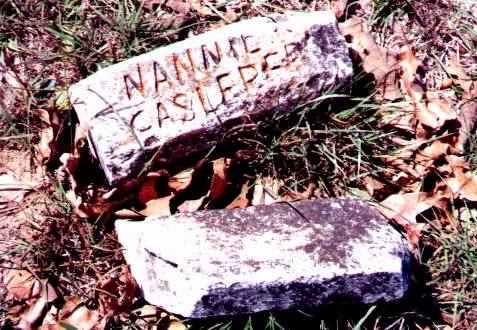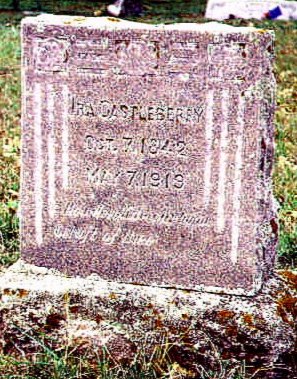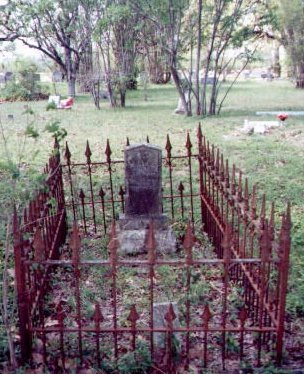OLDER GRAVES AT HAYNIE CHAPEL
CEMETERY:
 This grave for Mrs. E.L. Johnson (1877-1929) was in a fenced section of
Haynie Chapel cemetery with several other graves that belonged to her family
members. Her headstone is pink in color, is decorated with a feminine
floral print, and looks to be fairly new. Also, all of the graves
in this fenced area have flowers on them, so someone who knew her or related
to her might live nearby. Mrs. Johnson died in 1929, the year of
the worst stock market crash in the economic history of the United States
and the year that the Great Depression began. Her birth-year,
1877, is exactly 100 years before mine.
This grave for Mrs. E.L. Johnson (1877-1929) was in a fenced section of
Haynie Chapel cemetery with several other graves that belonged to her family
members. Her headstone is pink in color, is decorated with a feminine
floral print, and looks to be fairly new. Also, all of the graves
in this fenced area have flowers on them, so someone who knew her or related
to her might live nearby. Mrs. Johnson died in 1929, the year of
the worst stock market crash in the economic history of the United States
and the year that the Great Depression began. Her birth-year,
1877, is exactly 100 years before mine.
 This broken headstone was in an older section of the cemetery. Some
of the graves surrounding this one were 150 or more years old. The
first name on this grave is Nannie and the last has been partially rubbed
off by erosion. The name looks to be hand-carved.
This broken headstone was in an older section of the cemetery. Some
of the graves surrounding this one were 150 or more years old. The
first name on this grave is Nannie and the last has been partially rubbed
off by erosion. The name looks to be hand-carved.
 Though these two graves are not marked with birth or death years, I think
that the men who are buried in them may actually be Confederate Soldiers
because of the distinctive star on the top of the headstones. Possibly,
they fought or even died in the Civil War. The last name on both
graves is Boatright. In the Haynie Chapel cemetery, there are several
more Boatrights. Other common last names that I saw during my visit
here were Berdoll, Caldwell, Castlebury, and Johnson. As I was photographing
this pair of graves, a slight breeze unfurled the flags.
Though these two graves are not marked with birth or death years, I think
that the men who are buried in them may actually be Confederate Soldiers
because of the distinctive star on the top of the headstones. Possibly,
they fought or even died in the Civil War. The last name on both
graves is Boatright. In the Haynie Chapel cemetery, there are several
more Boatrights. Other common last names that I saw during my visit
here were Berdoll, Caldwell, Castlebury, and Johnson. As I was photographing
this pair of graves, a slight breeze unfurled the flags.
For being over a hundred years old, this grave is in fair condition.
At one time, it looks as if there may have been an inscription on the base
of this grave, but it has been rubbed away by time and is no longer readable.
Hiram Castlebury (June 21st, 1890-December 27th, 1906) was a young man
when he died, around 16 years of age, and his death was close to the Christmas
holiday. Several more Castlebury markers, probably young Mr. Castlebury's
family, are located in this general area of the cemetery. Young
Mr. Castlebury's grave leans heavily to one side and will probably tip
over in a few years if not leveled.
  Here is another Castlebury gravesite for a woman named Ida (October 7th,
1842-May 7th, 1919.) Mrs. Castlebury died the same year that American
women finally won the right to vote, that Prohibition was set on alcohol,
and that European nations were rebuilding after the chaos of the first
World War. She lived through the Civil War, through WWI and was alive
when Texas was still "Tejas," a state under the dominion of Mexico.
The base of Mrs. Castlebury’s headstone is covered in several different
colors of moss or lichen and the top is heavily weathered.
Here is another Castlebury gravesite for a woman named Ida (October 7th,
1842-May 7th, 1919.) Mrs. Castlebury died the same year that American
women finally won the right to vote, that Prohibition was set on alcohol,
and that European nations were rebuilding after the chaos of the first
World War. She lived through the Civil War, through WWI and was alive
when Texas was still "Tejas," a state under the dominion of Mexico.
The base of Mrs. Castlebury’s headstone is covered in several different
colors of moss or lichen and the top is heavily weathered.
 This fenced grave didn't have any headstone that I saw, but there was a
wreath with the world "Grandma" written across it in red silk flowers.
Perhaps the reason that this grave area has been fenced off is that her
friends or family members were concerned that her grave would be trampled
or maybe they just wanted to set it apart from the others in this cemetery.
The vine-covered fence is certainly distinctive and if these are flowering
vines, such as a Clematis, I'm sure that Grandma's grave looks beautiful
when in full bloom.
This fenced grave didn't have any headstone that I saw, but there was a
wreath with the world "Grandma" written across it in red silk flowers.
Perhaps the reason that this grave area has been fenced off is that her
friends or family members were concerned that her grave would be trampled
or maybe they just wanted to set it apart from the others in this cemetery.
The vine-covered fence is certainly distinctive and if these are flowering
vines, such as a Clematis, I'm sure that Grandma's grave looks beautiful
when in full bloom.
 The image of the dove is so worn that it is barely even discernible on
the top of the tombstone of Bettie Casner (December 7th, 1885-April 15th,
1918). Several of the graves from the early 1900's have this same
white glaze finish and for the most part, they are better preserved than
other types of graves of this age.
The image of the dove is so worn that it is barely even discernible on
the top of the tombstone of Bettie Casner (December 7th, 1885-April 15th,
1918). Several of the graves from the early 1900's have this same
white glaze finish and for the most part, they are better preserved than
other types of graves of this age.
 A rusty fence surrounds another grave nearby. The stone had deteriorated
so much that I was unable to read a name or date from it. The wrought-iron
details and the designs on the fence surrounding this site were heavily
coated in rust but are still very elegant looking. The left side
of the fence is beginning to sink and is noticeably crooked in this photograph.
A rusty fence surrounds another grave nearby. The stone had deteriorated
so much that I was unable to read a name or date from it. The wrought-iron
details and the designs on the fence surrounding this site were heavily
coated in rust but are still very elegant looking. The left side
of the fence is beginning to sink and is noticeably crooked in this photograph. |










